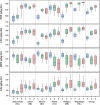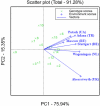Stability of Cell Wall Composition and Saccharification Efficiency in Miscanthus across Diverse Environments
- PMID: 28111583
- PMCID: PMC5216675
- DOI: 10.3389/fpls.2016.02004
Stability of Cell Wall Composition and Saccharification Efficiency in Miscanthus across Diverse Environments
Abstract
To investigate the potential effects of differences between growth locations on the cell wall composition and saccharification efficiency of the bioenergy crop miscanthus, a diverse set of 15 accessions were evaluated in six locations across Europe for the first 3 years following establishment. High-throughput quantification of cellulose, hemicellulose and lignin contents, as well as cellulose and hemicellulose conversion rates was achieved by combining near-infrared reflectance spectroscopy (NIRS) and biochemical analysis. Prediction models were developed and found to predict biomass quality characteristics with high accuracy. Location significantly affected biomass quality characteristics in all three cultivation years, but location-based differences decreased toward the third year as the plants reached maturity and the effect of location-dependent differences in the rate of establishment reduced. In all locations extensive variation in accession performance was observed for quality traits. The performance of the different accessions in the second and third cultivation year was strongly correlated, while accession performance in the first cultivation year did not correlate well with performance in later years. Significant genotype-by-environment (G × E) interactions were observed for most traits, revealing differences between accessions in environmental sensitivity. Stability analysis of accession performance for calculated ethanol yields suggested that selection for good and stable performance is a viable approach. Environmental influence on biomass quality is substantial and should be taken into account in order to match genotype, location and end-use of miscanthus as a lignocellulose feedstock.
Keywords: GGE biplot; biomass quality; ethanol; genotype-by-environment interaction; miscanthus; multi-location trial; near-infrared spectroscopy (NIRS); stability.
Figures




References
-
- Allison G. G., Morris C., Clifton-Brown J., Lister S. J., Donnison I. S. (2011). Genotypic variation in cell wall composition in a diverse set of 244 accessions of Miscanthus. Biomass Bioenergy 35, 4740–4747. 10.1016/j.biombioe.2011.10.008 - DOI
-
- Argillier O., Barrière Y., Traineau R., Emile J. C., Hebert Y. (1997). Genotype × environment interactions for digestibility traits in silage maize estimated from in vivo measurements with standard sheep. Plant Breeding 116, 423–427. 10.1111/j.1439-0523.1997.tb01025.x - DOI
-
- Arnoult S., Mansard M.-C., Brancourt-Hulmel M. (2015). Early prediction of biomass production and composition based on the first six years of cultivation. Crop Sci. 55, 1104–1116. 10.2135/cropsci2014.07.0493 - DOI
-
- Barrière Y., Thomas J., Denoue D. (2008). QTL mapping for lignin content, lignin monomeric composition, p-hydroxycinnamate content, and cell wall digestibility in the maize recombinant inbred line progeny F838 × F286. Plant Sci. 175, 585–595. 10.1016/j.plantsci.2008.06.009 - DOI
-
- Becker H., Leon J. (1988). Stability analysis in plant breeding. Plant Breed. 101, 1–23. 10.1111/j.1439-0523.1988.tb00261.x - DOI
LinkOut - more resources
Full Text Sources
Other Literature Sources

